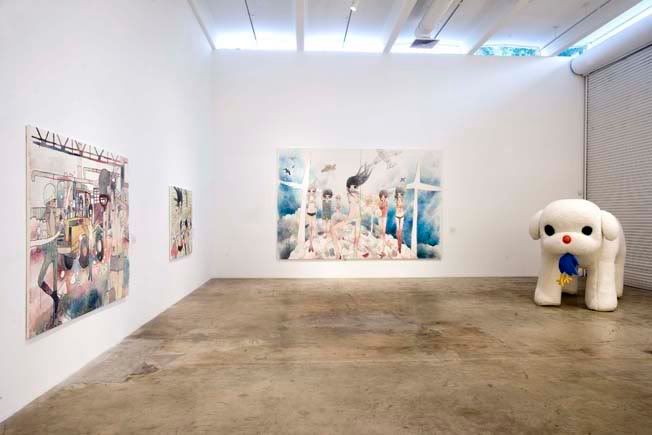
Feb. 10, 2007 – April 7, 2007
Gallery Emmanuel Perrotin Miami
Aya Takano's solo show in Miami is based upon the artitst's trip to a trash disposal plant.
From the KaiKai Kikii site:
The story: One day Aya Takano noticed a strange windmill outside her studio in the Tokyo Bay Area. She found there a waste disposal plant built on a landfill. From this spectacular sight came tales of girls and animals born and raised in a world buried in trash. The story of these mysterious lanky girls and their symbiotic co-existence with these new bird- and dog-like life forms touched the hearts of the denizens of Miami, a city perpetually sinking from global warming.
Aya Takano: There is a Science Fiction author, James Tiptree, Jr. whom I like. In one of her unfinished long works, I remember a scene where children born without hands or feet (the result of radiation from a nuclear bomb or something) cooperate with each other to drive a large car in their departure to somewhere. Also, there is a really wonderful Japanese comic book called Nausicaa, where the atmosphere has become poisonous--deadly to a person of this world--as the result of a large war. Both of these stories portray poisonous environments, but ones in which life continues.
When I shared my experiences at the waste site with people around me, I was told me that in some landfills, plants grow that have adapted to poison. It reminded me of how insects adapt to withstand pesticide. I heard that billions of years ago, most creatures on Earth were extremely sensitive to oxygen. As oxygen increased on the planet, many of them died off. One atmosphere might be unsurvivable for one creature, yet optimum for another. I also hear that there is life on the inside of deepsea volcanoes, the inside of clay, and other places where we previously thought it could not exist. I thought that the children who might be born sometime on this waste site, who might seem like mutants to us, are Venuses of this new world. I consider them beautiful.
To get rid of trash, no matter what we do, as long as we live on this planet, and as long as the systems we have continue to be effective, will not be possible. In the Edo Period (over 100 years in the past), in Japan there was a perfect waste ecosystem, including human excretions, but there is no way to go back to that now. Vinyl and plastic do not decompose, even after hundreds of years. If children are born amongst the mountains of plastic and vinyl left by us and the generations before us, they might look at these mountains and find them beautiful. Well, at least, I think they are beautiful. It is the same as how I think that artificial buildings and lights are beautiful.


No comments:
Post a Comment
Thanks so much for visiting the TokyoBunnie blog, and for taking the time to comment!